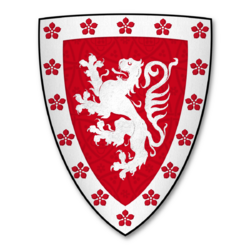Patrick V, Earl of March facts for kids
Patrick de Dunbar, 9th Earl of March (born around 1285, died 1369), was a very important Scottish noble. He lived during the time of two famous Scottish kings, Robert the Bruce and David II. Patrick de Dunbar was known for his strong leadership and for protecting Scotland.
Patrick's Early Life
Patrick's family was very old and powerful. They were the Earls of Dunbar, a title that meant they ruled a large area in East Lothian, Scotland. This area was also called March. His family was even connected to the ancient kings of Scotland.
Patrick became the Earl of March in 1309, when he was about 24 years old. This happened after his father, Patrick, 8th Earl of March, passed away. His family had a long history of being important figures in Scotland.
From Bannockburn to Durham
After the famous Battle of Bannockburn in 1314, Patrick de Dunbar showed great courage. He helped the English King, Edward II, escape from Scotland. King Edward had lost the battle, and Patrick gave him a safe place at Dunbar Castle. This castle was on the east coast of Scotland. From there, Patrick helped the king get back to England using a fishing boat.
After this, Patrick made peace with his cousin, Robert the Bruce, who was the King of Scotland. Patrick was present at an important meeting in Ayr in 1315. At this meeting, the Scottish leaders decided who would be the next king.
In 1318, Patrick helped Scotland take back Berwick-upon-Tweed from the English. He was also the Sheriff of Lothian, which meant he was a top official in that area. In 1320, he was one of the many nobles who signed the Declaration of Arbroath. This important letter was sent to Pope John XXII. It proudly declared that Scotland was an independent country and would not be ruled by England.
Around 1331, there was a disagreement about some land near the River Tweed. The Bishop of Durham in England said the village of Upsettlington belonged to him, not to Earl Patrick. The King of England got involved, and it seems the land was given back to the Bishop.
In 1332, Patrick de Dunbar was chosen as a joint Guardian of the Crown for Scotland. This happened after the previous Guardian, Thomas Randolph, 1st Earl of Moray, died. This meant Patrick was helping to rule Scotland. He fought against Edward Balliol, who was trying to become King of Scotland with English support.
In 1333, Patrick was in charge of Berwick Castle. However, after the Battle of Halidon Hill, he had to give up the castle. Earl Patrick and other Scottish nobles then promised loyalty to King Edward III of England. In 1334, they agreed to give England several important Scottish towns, including Berwick and Dunbar. King Edward III even made Patrick rebuild Dunbar Castle at his own cost. The castle was finally returned to Patrick in 1338.
In 1335, Patrick helped defeat the Count of Namur at the Battle of Boroughmuir, near Edinburgh. He also helped the High Steward of Scotland take back Perth in 1339.
In 1340, Patrick and the Earl of Sutherland were defeated by English forces during some border fights. In 1342, Patrick traveled to England with a special pass.
Patrick de Dunbar led part of the Scottish army at the Battle of Neville's Cross near Durham. Some stories say he escaped with many losses, including his wife's brother. Other stories say he retreated early without losing many men.
In 1355, Patrick, along with William, Lord of Douglas, invaded Northumberland in England. They also managed to take back Berwick-upon-Tweed, though not the castle. In 1357, he was one of the Scottish leaders who met to discuss freeing King David II. King David had been captured at Neville's Cross. Patrick was even held as a hostage until the king's ransom was paid. After this, his town of Dunbar became a special "Royal Burgh," which meant it had more rights.
In 1366, Patrick went on a pilgrimage to a holy place in Canterbury, England. In 1367, he confirmed that some lands, like Edrom and Nisbet, belonged to the monks of Coldingham Priory. He did this with his wife's agreement.
In 1368, the Scottish Parliament suggested that the King should talk to the Earls of Dunbar and Douglas about protecting the eastern borders. Patrick was not at the crowning of King Robert II in 1371, so it is thought he died before then, possibly in 1368 or 1369.
Marriage and Family
Patrick Dunbar is often remembered because of his second wife, Agnes Randolph. She was also known as Black Agnes of Dunbar. She died just a few months before him. Agnes was a very strong and brave woman. She inherited many lands from her brothers, including the Isle of Man and the Lordship of Annandale. These lands became part of her marriage to Patrick. She also owned other areas like Mordington, where she is buried.
| Preceded by Patrick IV |
Earl of March (or Dunbar) 1308–1369 |
Succeeded by George I |


